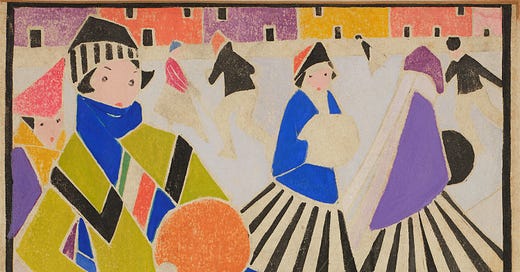The Colorful, Woodblocked World of Juliette Nichols
And introducing the Provincetown Printmakers.
❥ This email may be truncated in your inbox. To make sure you are reading the entire post, please move yourself along to a web browser!
More from me + Absolument can be found in these places:
Website | Instagram | Shop Absolument | Book Recs - Merci, thank you tons and tons for reading!
Phillips is having an auction tomorrow, Modernism 1880-1960: Editions & Works on Paper, which introduced me to the artist Juliette Nichols. I’ve quickly become obsessed. Here’s a hurried love letter to her color-punctuated woodcuts from the mid-1910s. The geo-specific history of the prints is almost as captivating as the art pieces themselves!
Phillips auction house states:
“In this sale, Phillips is proud to present the largest group of Nichols’ works to ever come to auction, offering 33 total impressions of 15 woodcuts and white-line woodcuts, along with two works on paper. Through these artworks, the spirit of the Provincetown Printmakers comes to life, demonstrating the radical nature of their process through varied impressions of the same composition, the use of collage and hand-coloring, and a palette that rivals that of Matisse and the Fauvists.”

“The Provincetown Print”
Provincetown, Massachusetts, holds a strong, art-focused reputation, especially in relation to artist and educator Hans Hofmann, who founded his famed art school there in the early 1930s.
Fifteen years prior, artists—both American and foreign—were settling in the region while immigrating and escaping from the dangers and damages of World War I. The village, resting on the northern edge of Cape Cod, was described in a 1916 article of Boston Globe as being “the biggest art colony in the world…one of nature’s laboratories in which creative minds and artistic souls can work.”
Among these artists were printmakers—artists who preferred paper as the backing of their primary communication device. A notable few were women: Juliette Nichols, Maud Squire, Ethel Mars, Mildred “Dolly” McMillen, Dorothy Loeb, Edith Lake Wilkinson, Blanche Lazzell, and Ada Gilmore. Juliette had met some of these printmakers while on a trip to Paris early in the previous decade. She, surely, must have been ecstatic to be reconnected and share a community together in Provincetown, especially during this time of political turmoil.





